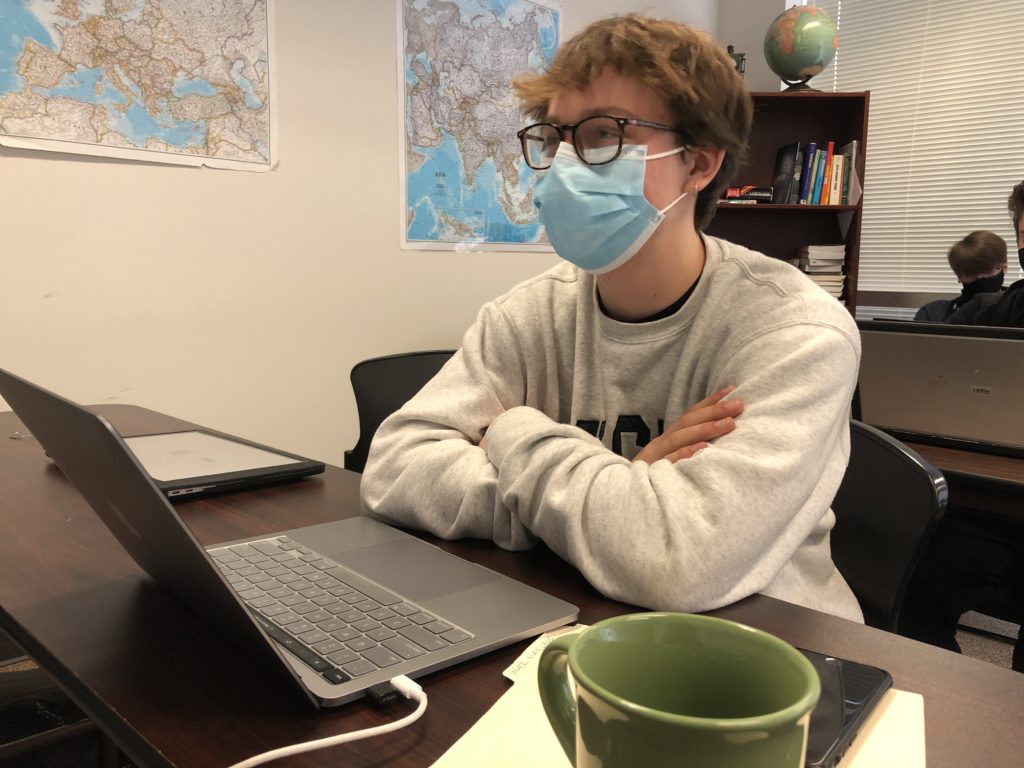In a perfect world, school would be a relatively stress-free environment reserved for learning. However, we live on the planet Earth, and anxiety and stress are and will continue to be a facet of going to Northwest Academy. The entire Pigeon Press staff has gathered their personal worries of students in 2022, school related or otherwise, so that we may reflect on the stressors in all our lives.
College Admissions
Admission to a top college is a primary reason that many students attend Northwest Academy, which means that the admissions process can be a considerable source of anxiety.
“The entire process is based on judging you solely from a couple of things that you put on a paper,” said Mazie Drummond, a senior. “Everyone that’s applying to college is a full being and it kind of strips that down a little bit.”
For seniors, juniors and even sophomores, the stresses of applying to college can become very real very quickly. Many overburden themselves with classes they don’t really want to take or end up spending too much time on applications.
Studying for and taking the SAT or ACT is a particularly stressful part of the application process, although fortunately it is no longer required for most schools. Still, some students invest considerable time and effort in preparing for the tests, either studying on their own or as part of expensive prep courses.
2022 was a particularly difficult year for Northwest Academy’s rising seniors, who contended with an even more selective admissions process than usual. Seniors at Northwest Academy often didn’t get accepted to their first choice schools and had to make tough decisions about where they would attend. According to CBS News, acceptance rates at top schools such as Harvard, Yale and MIT continued to fall, part of a nationwide trend. Students deferring because of Covid and test-optional policies both contributed to the soaring number of applicants.
“It’s always stressful trying to figure out what you’re going to do once you leave home, but it was satisfying to get them done and it’s really satisfying to have committed,” said Drummond. – Jasper Selwood
Our Downtown Campus
Northwest Academy’s location is both a blessing and a curse. Access to downtown Portland allows students to go to a wide variety of food carts and restaurants during lunch, or study hall, if you’re an upperclassman. You can walk to the nearby park blocks, and enjoy some solitary time on a slightly moist park bench.
Still, downtown is not all sunshine and rainbows. Most students will have a few stories of getting harassed or hassled for cigarettes by a random person on the street. Stepping over dog feces and heroin needles on the pavement is a regular occurrence, even on the blocks the school occupies. Not to mention loud construction vehicles, sirens from a wailing ambulance or the exhaust pipe from an unmuffled car. Distractions are numerous downtown, as well as potentially dangerous situations– this is something students simply learn to expect going to school at NWA.
Still, the school is taking steps in the right direction. The presence of more security, though probably unnecessary from a logistical standpoint, provides a safer environment for students walking between classes. It’s also a preemptive deterrent for any potential harassers, keeping them off the Northwest Academy campus.
And finally, perhaps we don’t need to shield the reality of Portland’s metropolitan area from our students. They will, in all likelihood, have to navigate cities much bigger than ours when they graduate high school, and they won’t always be pretty. Homelessness, the opioid epidemic and pollution are all things that cannot be ignored. By allowing students to be up close and personal with these problems, they can learn to understand them and potentially help to solve the many issues that affect Portland’s citizens. – Asher Wolfsmith
Time Management
Time management is one of the most important life skills students develop in high school, but it’s also one of the biggest stressors they face. Without the proper allocation of assignments students, especially in the latter two grades of high school, can feel behind, stressed and anxiety-ridden. Deadlines will be missed, and in the end, grades will start to tumble down. Especially when the workload is heavy, it can be increasingly difficult to find an appropriate amount of time to complete manifold assignments in a short window. Procrastination is also a major issue; it’s the toxic trait of throwing away an assignment for later and doing it at the very last minute. Self-imposed cramming like this could result in the difference between average and excellent work, and to combat this, one must really formulate a helpful schedule for work time and get things done before the deadline.
“Procrastination is more likely when the task is meaningful and the individual cares about doing it well,” says social psychology professor Devon Price. “Procrastinators can stare at a screen or book for hours, paralyzed by fear. At that point, the best solution is to take a short break and engage in a relaxing activity.” This truly takes a lot of mental stability and effort, despite how menial it sounds, and it’s easy to see why so many students struggle with procrastination and time management as a whole. – Keaton Marcus
Parental Expectations
Every high school student has a story about a conversation they had with their parents after progress reports came out. It’s a story of expectation, anticipation and, too often, disappointment. Parents’ academic expectations put a lot of pressure on students, who are often made to feel as though they have to excel academically to make their parents proud. Fear of failure, resentment and disappointment are foremost in many students’ minds during grading. These feelings can become overwhelming, resulting in a detrimental effect on students’ mental health. Some students may choose to cope with this by overworking themselves, which is harmful both physically and mentally. Others lose faith in themselves, and their self-esteem and self-confidence take a hit. Teachers’ efforts to make the grading process as stress-free and straightforward as possible are in vain when such domestic pressures are present.
Some observation of a student’s academic performance is acceptable, even desirable, but the practice of setting a near-perfect goal sets students up for failure. Students each have their own way of achieving their full potential, and often parents are unable to visualize the path forward until it materializes. As the end of the year approaches, the shadow of college looms upon us, eyeing our GPAs, service hours and PE credits. Everywhere, the message is loud and clear: be the best of the best, and you can go anywhere. At home, this slogan becomes deafening. – Shambhava Srikanth
Covid-19
It’s probably no surprise that the global pandemic is on this list, as it has undeniably been looming over the shoulders of students since early 2020. Covid is stressful in many different aspects, as it not only brings fear for the health and safety of yourself and your loved ones, but for students, also creates a less-than-ideal school environment.
Not only did Covid push schools to an online format for a year and a half, but even now that we’re back in person, there are still a lot of obstacles in the way of a return to normal school life. Restrictions on where students can eat and drink and how they interact make for an irregular and somewhat uncomfortable school environment. Even with some of these restrictions being lifted towards the end of the year, the looming fear of another wave of Covid will be with us for a while.
One of the largest factors that contribute to stress among the student body, however, isn’t the fear of the physical symptoms of the virus, but rather the repercussions of missing large amounts of class. Being absent for an extended period of time will not only put you behind in the class material, but if you miss any tests or large assignments during that time, you’ll either need to do it while you’re sick at home (which is rough on your health), or to do two weeks of work and assignments in the following weeks, causing a large pileup to catch up on.
Even if the extremity of the Covid situation is dialing down, the looming fear of catching the virus is still prevalent in the student body. – Conor McGeady
Mental health
Mental health concerns have come to represent an increasing threat to younger generations. Diagnoses of conditions from anxiety and depression to eating disorders have spiked since the pandemic set in, but they were on the rise even before February 2020; according to The New York Times, the percentage of adolescents that reported experiencing a major depressive episode increased 60 percent from 2007 to 2019. The Times also said that the suicide rate among American teens jumped 40 percent between 2001 and 2019.
“Three decades ago, the gravest public health threats to teenagers in the United States came from binge drinking, drunken driving, teenage pregnancy and smoking,” says The Times. “These have since fallen sharply, replaced by a new public health concern: soaring rates of mental health disorders.”
A cause for this spike has yet to be definitively isolated–social media is often blamed, but other factors also come into play. Isolation brought on by the pandemic has exacerbated the problem, but many teens cite reasons from climate change to political unrest as contributors to anxiety and depression.
Northwest Academy has taken steps to support students: the school recently hired a second counselor and a new Dean of Students. Both of these staff members work with students across the community.
“I work with students by checking in with them and being a resource for whenever they are feeling like they need someone to talk to,” said Dean Kiara Walls in an October interview with The Pigeon Press.
Additional changes could offer even more improvements–for example, a reworking of the advisory system, which is meant to provide peer support, could help open up essential conversations about mental health between Northwest Academy students. – Aaron Drummond
Climate Change
Of the many things students are worried about, our changing climate is one of the most urgent issues. Scientific American predicts that we only have 11 years to save the earth before climate change spirals into a never ending irreversible cycle. With many older generations not even acknowledging the issue, it can sometimes seem like there is no hope to solve the problem.
There is a very real and urgent need among young people to quickly and effectively cut carbon emissions down drastically.
Many worry about the desecration of natural landscapes by large companies that have no moral code, which pollute many formerly pristine natural areas and exhibit a blatant disregard for the population’s health and well-being. These companies are backed and supported by the United States government, which exhibits extreme greed by allowing itself to be seduced by large payouts and political power.
Many students are staging protests and walkouts to try and help solve this problem, but they are often met with silence from both politicians and the general public, which can make the situation feel unsolvable.
This is causing a lot of stress and worry among young people, who are the most affected group and seemingly the only ones willing to step up to help solve this critically important issue in our world before it is too late. – Elliot Strom
Angst
If you walk into a restroom in the Plaza, Buchan or Main Street buildings, there’s a chance you’ll find a glossy poster on the inside of your stall. These little rectangles might have a bubbly gray telephone hanging over bold font that reads “Need To Talk” or printed-on sticky notes confirming that “We Can Help.” Each poster has at least one phone number to offer to a student in need.
Even without the advertising, an air of worry looms in every classroom. Teenage angst is nothing new. Coming-of-age movies have been using the same trope of anxiety-riddled teens and their awkward misadventures for generations. Obnoxious Hollywood movies, however, don’t make these fears any less real. With seniors going off to college and freshmen testing the waters of high school, there’s an air of angst that hangs over everybody. Occasionally there’s a student crying into their binder during study hall or pacing hurriedly by the water fountain. Seniors can debate college versus gap year all they want but at the end of the semester, they’ll all be wearing a cap and gown just the same. Sophomores can spend advisory complaining about how theirs is the most difficult grade-level, but most get their notations in on time. Whether it’s Instagram accounts dedicated to anonymous bullying or whisper-shouting matches in the hallway, those dramatic, teenage angst feelings run their course no matter what. – Daisy Cody
Growing up and learning about one’s sexuality in a heteronormative society sucks. The constant pressure of male and female relationships is prevalent everywhere. Sexuality is always adapting and changing, and it’s a very difficult landscape to navigate as a young person. Identifying oneself as anything other than straight is often looked down upon or not taken seriously, especially when expressed by a young person. Adults spend too much time being ashamed of their sexuality and it only causes children to have unrealistic expectations of sex and what it should be.
Figuring out sexuality in high school can be all over the place and a lot of the time people don’t know where to start. Growing up anything other than straight is painfully confusing. Separating platonic and romantic feelings can sometimes seem impossible. It’s a process of constantly questioning oneself and feeling guilty for liking people. Straight people can be either aggressively supportive or become super uncomfortable.
There’s no way that a single person’s confusion around sexuality is going to represent everybody else going through the same thing. However, feeling comfortable in one’s own sexuality should be something that everybody gets to experience. It’s okay not to identify with one label all the time, and you don’t have to fit into a specific label in order to make your identity valid. – Kamea Morita
Lack of Sleep
Stress and lack of sleep are very closely related, especially in a school environment, because of their constant effect on our daily lives. Unfortunately, getting a good night’s sleep is very complicated for students. Northwest Academy does not start particularly early, but being in line with other schools doesn’t necessarily mean the schedule is good. Many students wake up early to get ready and commute in the morning, and they go to bed late at night after spending hours on homework.
For Northwest Academy students, sleep issues can also be dependent on geographical location. If someone is outside the Portland Metro area or lives far from Downtown, they might have to wake up even earlier just so they can get to school on time. Students that participate in after-school activities, such as performances and Arts After Hour classes, have little to no time after school and often struggle to balance their activities and homework.
Homework can take up the majority of some days, and the workload each day is completely out of a student’s control–working late into the night only makes matters worse. Anxiety has a significant effect on stress levels before bed, and the more stressed a student is the more likely they are to suffer from insomnia. There are a million different things that keep an individual up at night, and stress only makes it worse. – Jack LaBar





Leave a Reply